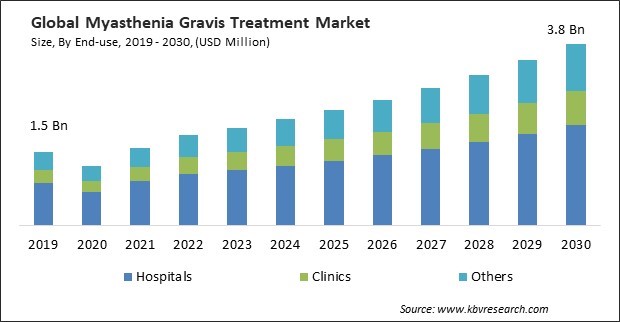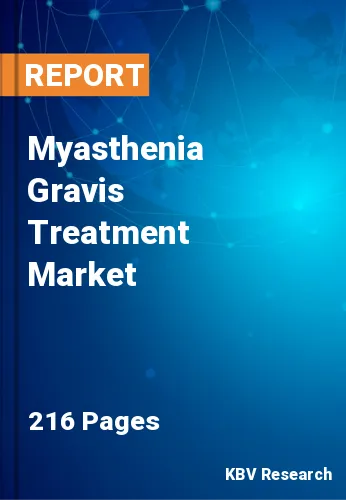The Global Myasthenia Gravis Treatment Market size is expected to reach $3.8 billion by 2030, rising at a market growth of 9.2% CAGR during the forecast period.
Better awareness and improved diagnostic techniques led to more cases being identified, increasing the demand for myasthenia gravis treatments, including chronic immunomodulators. Therefore, chronic immunomodulators segment captured $127.2 million revenue in the market in 2022. Research into autoimmune diseases, including myasthenia gravis, has spurred the development of newer and more effective chronic immunomodulators. Companies invest in developing improved formulations or alternative medications with better efficacy and fewer side effects. Thus, due to these factors, the segment will witness increased demand in the coming years. Some of the factors impacting the market are increased awareness and diagnosis of myasthenia gravis, growing usage and development of biological drugs and targeted therapies, and lack of treatment options for myasthenia gravis.

Early diagnosis means more identified cases of myasthenia gravis. This expands the patient pool seeking treatment. As more patients are diagnosed early, there's a higher demand for treatments, medications, and therapies, potentially creating a larger opportunity for pharmaceutical companies and healthcare providers. Early intervention often means a more manageable disease course. Moreover, as more attention is drawn to the disease, regulatory bodies and funding agencies might show increased interest. This can result in expedited review processes, regulatory support, and potentially increased funding for research and development in the myasthenia gravis treatment space. Additionally, unlike more generalized immunosuppressive treatments, biologics and targeted therapies focus on specific components of the immune system responsible for the autoimmune response in myasthenia gravis. For instance, some drugs may target B cells, producing autoantibodies that attack the neuromuscular junction. Moreover, introducing biological drugs has spurred increased research and clinical trials focusing on these targeted therapies. This ongoing research contributes to an expanding knowledge base and potential for further advancements in treatment options for myasthenia gravis. These aspects will drive the expansion of the market.
However, myasthenia gravis is known for its heterogeneity, meaning the symptoms, severity, and treatment response can differ significantly among individuals. What works well for one patient might not be as effective for another. This makes it challenging to find a universally effective treatment. Many medications commonly used to manage myasthenia gravis symptoms can lead to various side effects. These factors are expected to hamper the growth of the market.
Additionally, many individuals with chronic conditions like MG faced disruptions in their routine healthcare services due to overwhelmed healthcare systems, reallocation of resources, and restrictions on non-essential services during the pandemic's peak. Restrictions on in-person consultations limited access to specialized care from neurologists and other MG specialists, impacting disease management and individualized treatment plans. The unavailability or delay in receiving prescribed medications led to interruptions in the treatment, potentially impacting the control of MG symptoms. Inadequate access to essential medications resulted in disease exacerbations or flares, leading to increased weakness, fatigue, and other symptoms associated with MG. Therefore, the COVID-19 pandemic had a negative impact on the myasthenia gravis treatment market.
On the basis of type, the market is segmented into cholinesterase inhibitors, chronic immunomodulators, monoclonal antibodies, rapid immunotherapies, thymectomy, and others. The monoclonal antibodies segment recorded the maximum revenue share in the market in 2022. Monoclonal antibodies are a type of biological therapy that targets certain immune system components suspected to be involved in the etiology of myasthenia gravis.

Based on end-use, the market is divided into hospitals, clinics, and others. In 2022, the clinics segment witnessed a substantial revenue share in the market. Clinics specifically dedicated to neuromuscular disorders, including myasthenia gravis, provide comprehensive care with neurologists, immunologists, and other specialists experienced in managing this condition. The demand for specialized care could fuel the growth of such clinics.
| Report Attribute | Details |
|---|---|
| Market size value in 2022 | USD 1.9 Billion |
| Market size forecast in 2030 | USD 3.8 Billion |
| Base Year | 2022 |
| Historical Period | 2019 to 2021 |
| Forecast Period | 2023 to 2030 |
| Revenue Growth Rate | CAGR of 9.2% from 2023 to 2030 |
| Number of Pages | 216 |
| Number of Table | 290 |
| Report coverage | Market Trends, Revenue Estimation and Forecast, Segmentation Analysis, Regional and Country Breakdown, Porter’s 5 Forces Analysis, Company Profiling, Companies Strategic Developments, SWOT Analysis, Winning Imperatives |
| Segments covered | Type, End-use, Region |
| Country scope |
|
| Companies Included | AstraZeneca PLC (Alexion Pharmaceuticals, Inc.), Octapharma AG, Novartis AG, Pfizer, Inc., Allergan PLC (AbbVie, Inc.), F. Hoffmann-La Roche Ltd., GlaxoSmithKline PLC (GSK), Bausch Health Companies Inc., Kedrion S.p.A, and Zydus Lifesciences Ltd. |
| Growth Drivers |
|
| Restraints |
|
By region, the market is segmented into North America, Europe, Asia Pacific, and LAMEA. The North America segment procured the highest revenue share in the market in 2022. North America has seen a considerable prevalence of myasthenia gravis. Better diagnostic capabilities and increased awareness among healthcare professionals have led to more accurate and timely diagnoses of the condition, driving the demand for treatments.
Free Valuable Insights: Global Myasthenia Gravis Treatment Market size to reach USD 3.8 Billion by 2030
The market research report covers the analysis of key stake holders of the market. Key companies profiled in the report include AstraZeneca PLC (Alexion Pharmaceuticals, Inc.), Octapharma AG, Novartis AG, Pfizer, Inc., Allergan PLC (AbbVie, Inc.), F. Hoffmann-La Roche Ltd., GlaxoSmithKline PLC (GSK), Bausch Health Companies Inc., Kedrion S.p.A, and Zydus Lifesciences Ltd.
By End-use
By Type
By Geography
This Market size is expected to reach $3.8 billion by 2030.
Increased awareness and diagnosis of myasthenia gravis are driving the Market in coming years, however, Lack of treatment options for myasthenia gravis restraints the growth of the Market.
AstraZeneca PLC (Alexion Pharmaceuticals, Inc.), Octapharma AG, Novartis AG, Pfizer, Inc., Allergan PLC (AbbVie, Inc.), F. Hoffmann-La Roche Ltd., GlaxoSmithKline PLC (GSK), Bausch Health Companies Inc., Kedrion S.p.A, and Zydus Lifesciences Ltd.
The expected CAGR of this Market is 9.2% from 2023 to 2030.
The Hospitals segment is registering maximum revenue in the Market by End-use in 2022;there by, achieving a market value of $2.1 billion by 2030.
The North America region is generating the highest revenue in the Market by Region in 2022 and would continue to be a dominant market till 2030;there by, achieving a market value of $1.8 billion by 2030.
Our team of dedicated experts can provide you with attractive expansion opportunities for your business.

